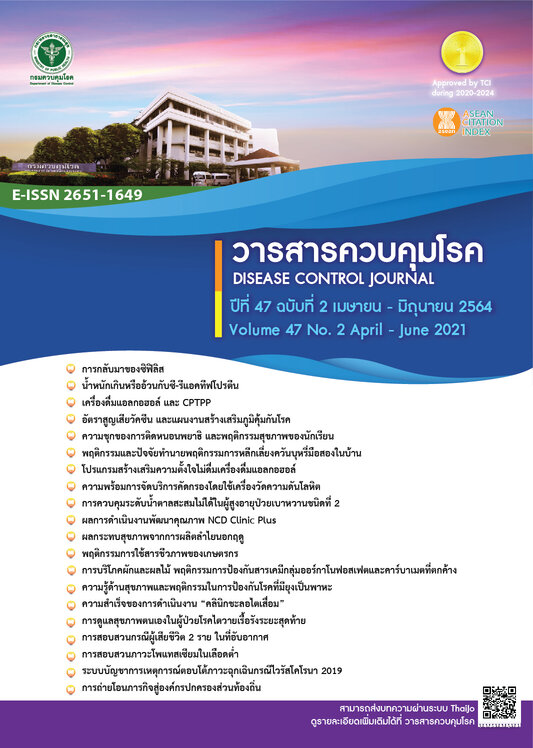An Investigation of two deaths in confined space from artesian well, Bang Khan District, Nakhon Si Thammarat Province, March 2020
DOI:
https://doi.org/10.14456/dcj.2021.34Keywords:
investigation, confined space, death, artesian well, hypoxiaAbstract
Background: The Situation Awareness Team (SAT), Department of Disease Control, was notified by the Office of Disease Prevention and Control 11 Nakhon Si Thammarat (ODPC11) on March 7th, 2020 that two workers died after dredging mud in the artesian well in Bang Khan District, Nakhon Si Thammarat Province. Division of Occupational and Environmental Diseases, the ODPC11 and Nakhon Si Thammarat Public Health Office jointly investigated on 12th March 2020. The objectives were to verify diagnosis, describe the incident, to identify the potential risk and to provide control measures to prevent further fatalities. Methods: We reviewed medical records and forensics records and interviewed the witnesses and doctors. We surveyed at incident scene and measured gases such as oxygen, carbonmonoxide, hydrogen sulphide and methane at the incident and nearby wells. The data were analyzed using descriptive statistics such as percentage, average. The oxygen and other toxic volume measurement and various toxic gases were described as a percentage by volume (% by volume) and a part of a million (ppm), respectively. Results: We found five people who exposed to the well, resulting in two deaths (attack rate 40%). The first death was the worker who was employed for dredging the well and the second death was rescuer. Both of them were not wear personal protection equipment for working in confined space. The causes of the first and second death were hypoxia and drowning, respectively. We detected that the level of oxygen is below the standard and no other toxic gases were found. Conclusions and discussions: The fatalities were suspected death in the confined space. Causes of deaths were likely due to the hypoxia. Lack of personal protective equipment and delayed assistance due to lack of rescue equipment are critical issues. Therefore, measures should be emphasized on awareness and preparing rescue equipment before working in a confined space.
Downloads
References
Ministry of Labour. Ministerial regulations prescribing standards for the management and operation of safety occupational health and working environment related to confined spaces, 2019 [Internet]. [cited 2020 Sep 9]. Available from: http://122.155.89.37/index.php?option=com_content&view=article&id=1930%3A-m-m-s&catid=1%3Anews-thai&Itemid=201 (in Thai)
Siripanich S. Injury and death from work in confined spaces during the year 2003-2018 Nonthaburi: Bureau of Epidemiology, Department of Disease Control; 2019. (in Thai)
Division of Occupational and Environmental Diseases, Department of Disease Control Event-based January - May 2020. Nonthaburi: Bureau of Occupational and Environmental Diseases, Department of Disease Control; 2019 (in Thai)
The National Institute for Occupational Safety and Health (NIOSH). Criteria for a recommended standard: working in confined spaces. December 1979 [Internet]. [cited 2020 May 10]. Available from: https://www.cdc.gov/niosh/docs /80-106/default.html
The National Institute for Occupational Safety and Health (NIOSH). Fatality Assessment and Control Evaluation (FACE) program: Confined Space [Internet]. [cited 2020 May 10]. Available from: https:// https://wwwn.cdc.gov/NIOSH-FACE/Default.cshtml?Category=0004&Category2=ALL%20accessed%20January,%202017
Botti L, Duraccio V, Gnoni MG, Mora C. An integrated holistic approach to health and safety in confined spaces. J Loss Prev Process Ind. 2018;55:25–35.
The National Institute for Occupational Safety and Health (NIOSH). Request for assistance in preventing occupational fatalities in confined spaces. June 2014 [Internet]. [cited 2020 Sep 9]. Available from: https://www.cdc.gov/niosh/docs/86-110/
Keadthongthawee S, Hungmitr C, Chaiyanuwatiwong S, Panta C. The study check quantity of oxygen compared with depth in confined space (ground water well) in Region Health 3. Journal of Disease and Health Risk DPC.3. 2018;13(1):17-24.
Milroy M. Deaths from environmental hypoxia and raised carbon dioxide. Acad Forensic Pathol. 2018;8(1):2‐7.
Selman J, Spickett J, Jansz J, Mullins B. Work-related traumatic fatal injuries involving confined spaces in Australia, 2000–2012. J Health Saf Environ. 2017;33:197–215.
Wilson MP, Madison HN, Healy SB. Confined space emergency response: assessing employer and fire department practices. J Occup Environ Hyg. 2012;9(2):120-8.
Issa SF, Cheng YH, Field WE. Summary of agricultural confined-space related cases: 1964–2013. J Agric Saf Health. 2016;22(1):33-45.
Riedel SM, Field WE. Summation of the frequency, severity, and primary causative factors associated with injuries and fatalities involving confined spaces in agriculture. J Agric Saf Health. 2013;19(2):83-100.
Selman J, Spickett J, Jansz J, Mullins B. An investigation into the rate and mechanism of incident of work-related confined space fatalities. Saf Sci. 2018;109:333–43.
Downloads
Published
How to Cite
Issue
Section
License
Articles published in the Disease Control Journal are considered as academic work, research or analysis of the personal opinion of the authors, not the opinion of the Thailand Department of Disease Control or editorial team. The authors must be responsible for their articles.






